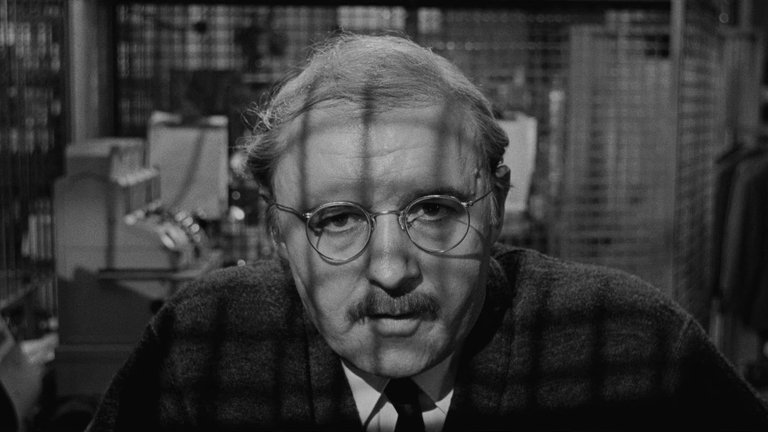
The 1960s were a transformative decade in the history of cinema, marked by a plethora of films that pushed boundaries and explored new themes. Amidst this vibrant landscape, numerous films that might have otherwise garnered acclaim for their innovative qualities or significant themes have faded into obscurity, overshadowed by more commercially successful or flamboyant productions. One such film is Sidney Lumet's 1964 drama The Pawnbroker. Despite its groundbreaking nature in several respects, it remains one of the lesser-known works from both the 1960s cinema and Lumet's distinguished filmography.
The Pawnbroker is adapted from Edward Lewis Wallant's 1961 novel of the same name. The narrative centres on Sol Nazerman, a Jewish immigrant and pawnshop owner in East Harlem, portrayed by Rod Steiger. Once a university professor in Europe, Nazerman's life was irrevocably altered when he lost his family to the horrors of Nazi concentration camps. Now residing in a Long Island suburb with his sister-in-law Bertha (played by Nancy R. Pollock), another Holocaust survivor who, unlike him, has managed to rebuild her life, Nazerman grapples with emotional detachment resulting from his traumatic past. This emotional coldness serves him well in business, as many of his customers are desperate and impoverished. His young Puerto Rican assistant, Jesus Ortiz (played by Jaime Sanchez), admires him and dreams of one day running his own pawnshop. However, as Nazerman rebuffs the advances of Marilyn Birchfield (played by Geraldine Fitzgerald), a middle-aged social worker and widow, the suppressed traumas begin to disrupt his relationships, particularly with Rodriguez (Brock Peters), a local gang boss who uses the pawnshop as a front for his illicit activities.
One of the primary reasons The Pawnbroker holds significance in cinematic history is its status as the first major Hollywood film to tackle the Holocaust from a survivor's perspective. While earlier films had touched on this dark chapter of history, they often did so superficially. In contrast, The Pawnbroker delves deeply into the psyche of its protagonist, making trauma and its repercussions a central theme. This direct engagement with the Holocaust marked a pivotal moment in American cinema, paving the way for more nuanced portrayals of such sensitive subjects.
Another groundbreaking aspect of Lumet’s film is its bold challenge to the MPAA Production Code, particularly regarding nudity. The film includes scenes featuring Thelma Oliver as Ortiz’s prostitute girlfriend and Linda Geiser as Nazerman’s deceased wife, both of whom expose their breasts. The producers defended these scenes as essential to conveying Nazerman's traumatic memories associated with his wife's abuse at the hands of Nazis. During this period, MPAA censors were gradually becoming more lenient, allowing The Pawnbroker to receive a "special exception" certificate despite pressure from Catholic and other conservative groups. This decision effectively opened doors for nudity in American cinema and contributed to the ultimate decline of the Production Code, which was replaced by an age-specific rating system just four years later.
Despite its historical significance and intense public discourse surrounding its content prior to its 1965 U.S. premiere, The Pawnbroker has not remained particularly well-remembered. A key reason for this is its challenging nature; it is not an easy film to watch. The black-and-white cinematography by Boris Kaufman may have seemed dated to audiences in the mid-1960s, giving it an air of pretentiousness often associated with art cinema. Additionally, Lumet’s use of instantaneous flashbacks—akin to those in Hiroshima Mon Amour—can render the plot somewhat perplexing.
Further complicating audience reception is the character of Sol Nazerman himself. As a cold and seemingly heartless individual who exploits his impoverished clientele, he can be difficult to empathise with despite his traumatic backstory. This emotional distance is exacerbated by his actions in the film's climax; when trouble finally confronts him, viewers may find themselves feeling more sympathy for secondary characters who become collateral damage rather than for Nazerman himself. Although Rod Steiger delivers an unusually restrained performance that adds depth to his character, it is ultimately his portrayal that makes The Pawnbroker somewhat easier for viewers to digest.
Critics and audiences alike in the 1960s may have also found fault with what some perceived as heavy-handed parallels between contemporary America and Nazi-occupied Europe. Scenes depicting inner-city misery and violence could evoke memories of concentration camp horrors, which may have felt inappropriate or overly dramatic at that time.
Interestingly, The Pawnbroker largely sidesteps racial issues—a curious choice for a film addressing such profound themes related to ethnic persecution. Ortiz’s Puerto Rican heritage serves more as an exotic detail than as a focal point for exploration within the narrative. Similarly, Rodriguez's character, despite being black, enjoys a lifestyle that starkly contrasts with that of most middle-class whites—living luxuriously alongside what appears to be his white gay lover—yet these elements are not fully developed within the context of the plot.
The film's pervasive pessimism extends even to characters who might typically embody success within 1960s middle-class standards. For instance, Marilyn Birchfield resides in a modern apartment boasting stunning views; however, these vistas only serve as painful reminders for Nazerman of his orderly yet oppressive past in Germany. Likewise, Bertha’s suburban home appears stiflingly uniform and devoid of individuality—a reflection of Nazerman's legacy that her children remain blissfully unaware of.
Ironically, The Pawnbroker is perhaps best remembered today for Quincy Jones' exceptional musical score; specifically, its theme "Soul Bossa Nova" has become one of the most recognisable pop standards from the 1960s. This upbeat music seems incongruous against the backdrop of such a dark narrative.
While The Pawnbroker may suffer from certain confusing plot details and a somewhat predictable melodramatic ending, it remains a noteworthy film. Its steady direction, courtesy of Lumet, Jones’ soundtrack, and Steiger's good performance, make it a worthwhile watch, even for those who may not be interested in the film's historic importance.
RATING: 6/10 (++)
Blog in Croatian https://draxblog.com
Blog in English https://draxreview.wordpress.com/
InLeo blog https://inleo.io/@drax.leo
Hiveonboard: https://hiveonboard.com?ref=drax
InLeo: https://inleo.io/signup?referral=drax.leo
Rising Star game: https://www.risingstargame.com?referrer=drax
1Inch: https://1inch.exchange/#/r/0x83823d8CCB74F828148258BB4457642124b1328e
BTC donations: 1EWxiMiP6iiG9rger3NuUSd6HByaxQWafG
ETH donations: 0xB305F144323b99e6f8b1d66f5D7DE78B498C32A7
BCH donations: qpvxw0jax79lhmvlgcldkzpqanf03r9cjv8y6gtmk9
Posted Using INLEO